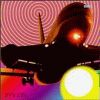Vision Creation Newsun
1999

Personnel:
eYe:
mix, vocals, synthesizers, samples, turntables, computer, electronics, edits
Yamamotor:
guitars, vocals
Hilah:
bass, effects, vocals
Yoshimi:
drums, percusions, casiotone, vocals
ATR:
drums, percusion, electric pad, vocals
E-Da:
drums, percussion, electric pad, vocals
with:
Kiyoshi Izumi:
Synth, samples
|
Boredoms continue to run rampant to a restless jungle beat with this fairly amazing album.
The band takes what it learned from the last album, sprinkles a pinch of electronica into the mix, and blends it all together to produce one of their best albums. They're still prancing paganesque around the pyre, and the rhythym is still ruling the show, but this time around the vibe is all about the sun. This album is almost celebratory in its worship of all things bright. Be prepared for a breath of fresh air, and a speedy ride to other planes. Trippy, to say the least.
All of the songs blend into each other, so there is almost a rave-like feel to the album. The music is similar to "Super Going" from Super æ, with more electronic manipulation, but fewer dynamic shifts. Each tune takes the same basic beat, but subtly altered, so you get the impression of movement rather than any actual outlined changes. The end result is an almost seamless piece of pure primal bliss.
Released in 1999 as a box set featuring another disc of otherwise unreleased live versions of the music, and a t-shirt. The single CD version was released in Japan in 2000, and elsewhere in 2001.
Representative tracks
 The first track on the album begins as if waking from a dream. Soon, eYe declares "New-Sunnn!", and we're off. A huge, noisy crescendo brings in the pounding drums, and pretty soon you'll swear you can see the natives begin to rustle. A great splash into the wild, and it really doesn't ever stop. The first track on the album begins as if waking from a dream. Soon, eYe declares "New-Sunnn!", and we're off. A huge, noisy crescendo brings in the pounding drums, and pretty soon you'll swear you can see the natives begin to rustle. A great splash into the wild, and it really doesn't ever stop.
 So, we're moving along nicely, with images of electric rays dancing in our heads, when all of a sudden everything comes into focus. Track 3 tones the drums down a bit, pipes in some tropical birds, and a adds a user-friendly synth line to glue the whole thing together. Contrary to anti-popular belief, Boredoms do know a thing or two about pacing, and for a few minutes the frenzy gives way to minimalist nirvana. So, we're moving along nicely, with images of electric rays dancing in our heads, when all of a sudden everything comes into focus. Track 3 tones the drums down a bit, pipes in some tropical birds, and a adds a user-friendly synth line to glue the whole thing together. Contrary to anti-popular belief, Boredoms do know a thing or two about pacing, and for a few minutes the frenzy gives way to minimalist nirvana.
|













 The first track on the album begins as if waking from a dream. Soon, eYe declares "New-Sunnn!", and we're off. A huge, noisy crescendo brings in the pounding drums, and pretty soon you'll swear you can see the natives begin to rustle. A great splash into the wild, and it really doesn't ever stop.
The first track on the album begins as if waking from a dream. Soon, eYe declares "New-Sunnn!", and we're off. A huge, noisy crescendo brings in the pounding drums, and pretty soon you'll swear you can see the natives begin to rustle. A great splash into the wild, and it really doesn't ever stop.
 So, we're moving along nicely, with images of electric rays dancing in our heads, when all of a sudden everything comes into focus. Track 3 tones the drums down a bit, pipes in some tropical birds, and a adds a user-friendly synth line to glue the whole thing together. Contrary to anti-popular belief, Boredoms do know a thing or two about pacing, and for a few minutes the frenzy gives way to minimalist nirvana.
So, we're moving along nicely, with images of electric rays dancing in our heads, when all of a sudden everything comes into focus. Track 3 tones the drums down a bit, pipes in some tropical birds, and a adds a user-friendly synth line to glue the whole thing together. Contrary to anti-popular belief, Boredoms do know a thing or two about pacing, and for a few minutes the frenzy gives way to minimalist nirvana.



